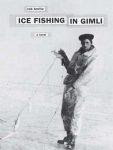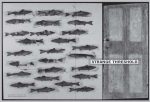Brooke Ford follows Rob Kovitz’s frozen odyssey
By Brooke Ford
“I have imagined a man who might live as the coldest scholar on earth, who followed each clue in the snow, writing a book as he went.” So begins Rob Kovitz’s recently completed Ice Fishing in Gimli, a 10-year project aptly named and emblematic of his distinctive literary style of building books entirely of other peoples’ writings and images.
Published by his own imprint, Treyf Books, the eight-volume bookwork is an assemblage of quotations from novels, travel brochures, philosophical writings, government papers and song lyrics as well as collages of photographs and film stills.
The opening quotation is taken from John Haines’s The Stars, the Snow, the Fire and works quite poignantly to evoke Ice Fishing’s methodology, setting and inner metaphors of snow, nothingness, fishing and, of course, writing and collecting.
The Winnipeg artist, writer and architect owes much of his inspiration for this “epic citation saga,” as he calls it, to the small town of Gimli itself and to his parent’s decision to retire to the beach community an hour outside Winnipeg. “The book is weirdly autobiographical,” says Kovitz.
Growing up in Winnipeg, Kovitz left his home for the University of Waterloo where he studied architecture. When he returned, it was to build his parents a little retirement house in Gimli. “Basically,” he adds, “a lot of the things you’re reading about parallel my experiences in that.”
Two progress editions were published prior to the completed eight-volume edition. The first in 2004 as an exhibition at Gallery OneOneOne in Winnipeg, and the second in 2006, as part of YYZ’s Artists’ Outlet in Toronto. Ice Fishing has taken up a substantial part of Kovitz’s literary career. Speaking of the time he spent on this project, Kovitz says: “I worked for about six or seven of the 10 years full-time, which is remarkable to say, I’m not Margaret Atwood,” he says. “I was lucky enough to string together a series of grants and worked very intensely for several years, living with these texts in my head.” He describes his creative process as “a process of complete emersion and discovery.” Indeed, after reading the first volume, one begins to feel engrossed, or better, transposed by the passages compiled in Ice Fishing. In one sense, you’re reading Kovitz’s book, but in another, you’re reading (again, or perhaps for the first time) the writings of Frederick Philip Grove, Mark Z. Danielewski, Roland Barthes, Talking Heads, The Weakerthans, David Arnason and a lot of Miguel de Cervantes — just a small chunk of the full roster. What makes Kovitz’s style so unique and compelling is that the quotations are stitched together to create a singular narrative voice among all these separate narratives.
When I ask him bluntly what his editing and research process is like, his laugh beams across the phone line as he tells me that “it takes a lot of work. It takes a lot of time to find that material but I think a lot of people presume that that’s the majority of the work, but I spend much more time figuring out which order it’s going in and getting that flow that you wouldn’t necessarily think can happen when you’re working with all these fragments.” For Kovitz, the relationship between the texts and the images are integral to the meaning of his work. “Somehow there’s something else besides the one text and then the next text whatever order it’s put in, and for me, it’s the gap between them and the reader has to make the links,” he says. “There are all these juxtapositions between the text or a series of texts and an image, which might not necessarily be an illustration of what’s going on in the text.” The passages that make up “exposition of method” at the start of the first volume resemble an introduction or a series of epigraphs that unearth some sinister notions about a writer’s intent, the fallacies of authorship and the uses of metafiction. One such passage reads: “His fantasy is to write a book entirely made up of quotations,” from Ricardo Piglia’s Artificial Respiration. The progress and structure of Ice Fishing in Gimli read like a tunnel system, stretching the boundaries and traditions of the novel form and the role of the author, where the author becomes more of a collector than a composer. “In the way that I work, the whole world could start you wanting to collect everything. I just start obsessing about certain things and then making decisions. For me, it’s an endless process of weird discoveries.”The obvious advantage to using a collection of quotations is that Kovitz can engage on various levels of metaphor and reality. His book hinges on the historical development of immigration to Manitoba, farming, ice fishing and tourism in Gimli; these act as thresholds to the metaphors of weather, loneliness, isolation, architecture and the nothingness of a landscape engulfed in snow or in dust.
“As you continue on in the volumes,” says Kovitz, “the second is mostly documentary, it has a lot to do with snow conditions and ice fishing on Lake Winnipeg. Then it starts to get more interiorized.” Ice Fishing becomes more character driven, as the landscape moves to represent the main character’s inner struggles. “In a way, the whole book is based on Don Quixote, a guy who’s kind of endearing but also maddeningly nuts. The character in the book sets out to build a house and doesn’t do that, he sets out to become a hermit but desire gets in the way, he sets out to have a relationship with a woman, he decides to become a mystic and it all doesn’t work out. Towards the end of the book, he appears to die but he doesn’t seem to be able to die.”
With his multi-compendium project, Ice Fishing in Gimli challenges that seemingly indelible trademark of the “Great Canadian Novel,” by offering an exciting and stylistically complex reinterpretation of the relationship between landscape and life. Before hanging up, Kovitz laughs over the reputation Manitoba gets for being a very cold city. “I think lots of artists in Winnipeg like to think, happily, that the cold weather is the reason why we all stay inside and make these weird things.”
Contact Rob Kovitz at treyf.com


